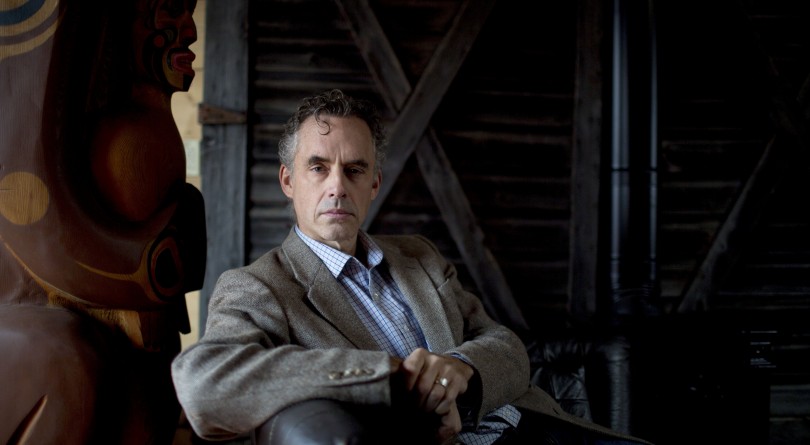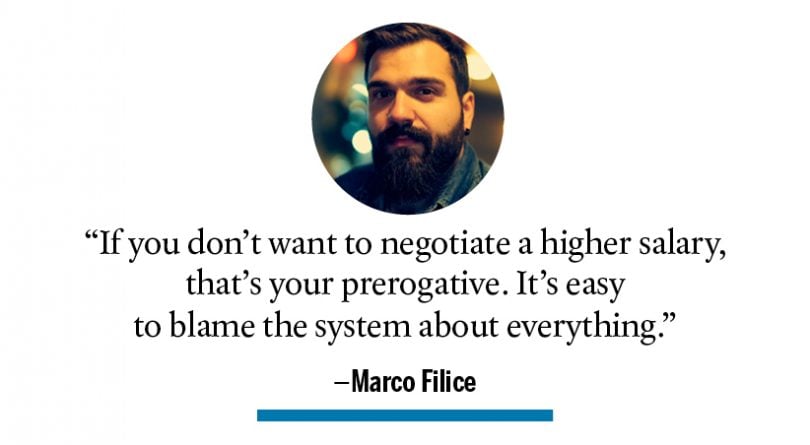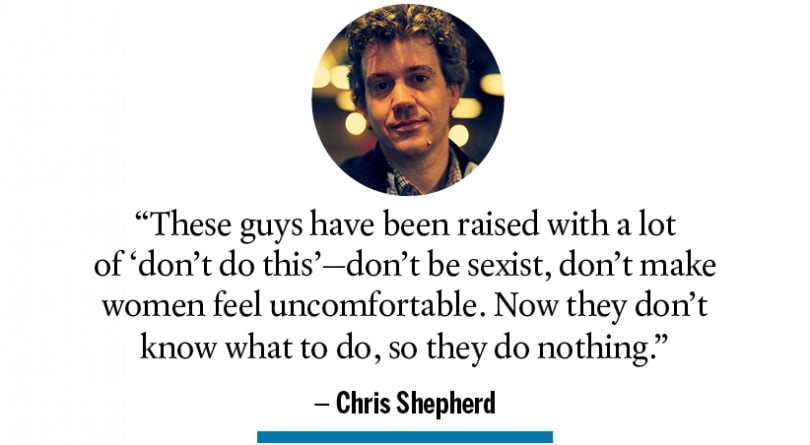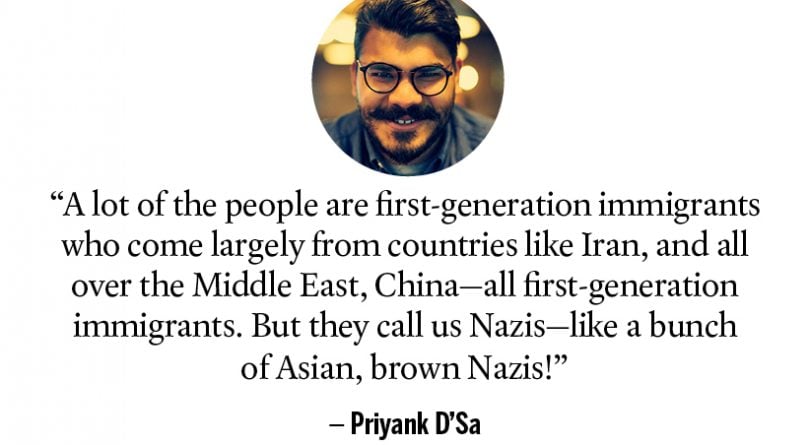Jordan Peterson’s people are not who you think they are
Peterson’s followers are often lumped in with the alt-right. In reality, they’re a diverse group of self-help junkies searching for meaning and order in a rapidly evolving age.

Jordan Peterson fans (L to R) Priyank D’Sa, Marco Filice and Chris “Tenmagnet” Shepherd. (Photograph by Daniel Ehrenworth)
Share
The founder of the Jordan Peterson Toronto Meetup Group, which gathers downtown for discussion every Tuesday night at a bar better known for meeting singles, is a 37-year-old dating coach named Chris “Tenmagnet” Shepherd, who believes his work with shy, lonely men dovetails nicely with Peterson’s pull-up-your-bootstraps-bucko philosophy.
Shepherd has billed himself as an original member of Toronto’s “Secret Underground Society of Pickup Artists,” whose principal players Neil Strauss profiled in his 2005 exposé The Game: Penetrating the Secret Society of Pickup Artists, and he has instructed men on how to score with women all over the world—from Toronto to Tokyo to Las Vegas and Dublin—in workshops that cost his students thousands of dollars.
Six years ago, in a Reddit post that presages his fascination with Peterson’s philosophy, he wrote: “I try to make my classes about much more than just picking up—they’re about confronting fear and learning how to be the man you want to be.”
Shepherd discovered Peterson’s YouTube talks in 2016 and soon found himself paying $30 a ticket to attend a series of 15 sold-out Bible lectures Peterson gave in Toronto last year. (Peterson tends to be coy about whether he believes in God but has called the Bible “vital to proper psychological health.”) “I knew Jordan Peterson was going to be really big before I signed up for the Biblical series—because I signed up for the Biblical series,” says Shepherd, who has a law degree from the University of British Columbia but has made his living as a dating coach for more than a decade. “If you had told me a year beforehand, ‘Chris, you’re going to eagerly attend a series of lectures on the Bible,’ I’d have said you were nuts.”

Among the entries Shepherd has posted to his business website over the past year—“The myth of toxic masculinity,” “Finding a wingman” and “The real secret to confidence (that nobody has told you yet)”—is Shepherd’s invitation to join his Peterson meetup group and help “rescue the west from the Underworld.”
Scheduled to follow the Bible lectures at the University of Toronto, where Peterson teaches psychology, Shepherd’s meetups draw as many as 40 Peterson enthusiasts each week. “I gotta tell you, there’s some interesting stories from these folks,” says Shepherd in a video promoting the events. “These people have really suffered, it seems, at the hands of some of these ideologues we’re now seeing in our universities and throughout our society—but everybody has a positive spirit going forward.”
Peterson—contrarian, unapologetic and often stern—is the unlikely media star whose lengthy lectures on everything from existentialism to The Lion King to the evils of political correctness have racked up millions of views on the internet. David Brooks, a New York Times columnist, says he may be the “most influential public intellectual in the Western world right now.” Peterson’s latest book, 12 Rules for Life: An Antidote to Chaos, a flinty how-to guide geared toward young men, continues to top Amazon’s most-read non-fiction list in the U.S. His incendiary appearance sparring with TV journalist Cathy Newman of Britain’s Channel 4 News about the gender pay gap and what women really want in men—and what they must often settle for—catapulted him to even larger celebrity (and increasingly expensive haircuts).
His diatribes against gender-neutral pronouns, identity politics and postmodernism have led many to dismiss him as a reactionary. (Last year, Peterson backed down on his plan to create a website listing university courses that promote such points of view, calling them “postmodern neo-Marxist cult classes,” to help parents and students identify and avoid them.) His followers are frequently lumped in with the loud, hateful alt-right, where there is little doubt he has support, or the internet trolls who rampaged against Newman after the Channel 4 interview went viral—with tweets so toxic her bosses said they brought in extra security. But based on the sales figures for 12 Rules (published in January, it has already moved a reported 700,000 copies in the U.S.), his sold-out speaking appearances, his nearly 10,000 paying Patreon supporters and his millions of YouTube hits, Peterson’s appeal is more mainstream than his critics might admit.
Because the first chapter of 12 Rules—“Stand up straight with your shoulders back”—delves into the dominance hierarchies of the lobster world, some fans have altered the Pepe the Frog meme associated with the far right so that Pepe looks red, antennaed and clawed. Some of Peterson’s online acolytes have even begun calling themselves lobsters.
But in a series of interviews with Shepherd and his circle—a diverse, earnest group of Peterson admirers—Maclean’s has uncovered instead a community of self-improvement junkies who appear less alt-right than uncertain about how to manage in a rapidly evolving age and eager to figure it out.
READ: Jordan Peterson and the big mistake of university censors
They say that in Peterson’s work they find a prescription of ancient stories and simple truths that gives them clarity and sometimes can even lead to self-transformation. While it is true that they are sometimes aggrieved by the new rules of etiquette governing pluralistic Canada—especially when it comes to matters of gender—their experiences are often as reflective of the broader Canadian mosaic as anyone’s. They are new Canadians, people of colour, men and women. And in a way that seems out of sync with op-ed portrayals of Peterson’s supporters as committed to preserving old hierarchies and positions of privilege—they often see themselves as searchers, truth-seekers and iconoclasts.
In this, Peterson—folksy, passionate, at times angry—is their guide and guru.
“Who’s the guy from the ’70s—Timothy Leary?” asks Shepherd’s friend Priyank D’Sa, a 25-year-old York University student. “I think Peterson is like the Timothy Leary of this era. Except Leary was about pushing back against the structure of the ’50s, whereas Peterson is all about structure—Peterson is required now because everything has become so open-ended, and he’s giving people a way to find purpose in their lives.”
The comparison to Leary isn’t as far-fetched as it might sound. Consider Marco Filice, a 31-year-old philosophy and religious studies grad from Hamilton, who first began taking Peterson’s work seriously last year after an accident while working at a machine shop left his right hand very terribly mangled and with missing fingers. “The image of looking at the hand was as bad as the pain itself,” says Filice, who took the job as a way of saving money for a teaching degree.
During his recovery, Filice watched hours of Peterson’s online talks. “He takes the existentialists seriously,” Filice explains, noting Peterson’s insistence that “life is tragic at bottom—you enter the world in excruciating pain and you die alone.”
Somehow, Filice says as he cradles his damaged hand at a café in Toronto, he found this message comforting: “Watching Jordan Peterson helped with the healing.”
‘The main thing is just to endure’
Filice began attending Peterson’s Bible talks, and ended up buttonholing him outside the last of these lectures. He had made plans to fly to Peru and participate in a series of hallucinogenic ayahuasca rituals in the jungle—part of his efforts to liberate himself from the emotional trauma of his accident. In a whisper, he told Peterson of that accident, then asked for his advice about how he should prepare himself for the powerful psychedelic experience he was about to undergo.
Peterson dropped the formalities and, using the kind of coarse language usually reserved for old friends or the locker room, addressed Filice as a peer.
“Just let it come, let it happen” Filice says Peterson told him. “The main thing is just to endure.”

In Peru, Filice’s encounters with ayahuasca “bridged the gap between the heavens and us,” he says, echoing the language of Peterson’s lectures, and led to a series of terrifying but therapeutic visions: “I saw those closest to me in caskets.” Back in Canada, he wrote to Peterson to update him on his trip. Peterson receives so many emails now, it’s natural Filice did not hear back.
To an extraordinary degree, Filice’s journey—from crisis to quest—tracks the narrative heroic arc at the core of Peterson’s lectures, which often dissect myths and legends of gallants old. As Shepherd, the dating coach, explains: “A good example is the knight who slays the dragon, and the thousands of stories that follow that theme. The moral is: sometimes there’s a bad thing hidden in a cave. It may be internal and psychological or it may be external, but it gets bigger if you ignore it. You have to assume the role of hero and fight it.”
(In dating-coach parlance, the terrifying dragon of legend is akin to the anxiety many men feel as they prepare to speak to a woman for the first time.)
Peterson lays the tenets of his philosophy out in long, dense, discursive lectures and in two weighty books—Maps of Meaning: The Architecture of Belief and this year’s 12 Rules. In essence, the idea seems to be that human beings, in confronting the unknowns of life in a harsh and chaotic world, are hard-wired to grab hold of that chaos and generate from it narratives.
Read these stories right—whether encoded in myth or echoed in novels by Peterson favourites like Tolstoy, Dostoevsky or Solzhenitsyn, even delivered to us in our dreams—and you secure a way of manoeuvring the uncaring anarchy of experience, even the rotten part of life that for Peterson is embodied in the wicked snake of Eden. Read them wrong, or fail to read them at all and so lose them (as Peterson believes is happening in the West), and you open the culture up to nihilism and leave it vulnerable to extremist ideologies.
It’s from nihilism that Filice, who grooms his thick black beard into a dramatic point, believes Peterson helped rescue him. Before his accident, Filice was fond of the pessimistic ideas he found in books by the American horror writer Thomas Ligotti and the philosopher David Benatar, who both inspired Matthew McConaughey’s misanthrope cop Rustin Cohle in HBO’s True Detective (where Filice first learned of them). “When I hurt my hand there was a real temptation to buy into that,” he says.
Peterson ‘is making me a believer’
Peterson taught him the true meaning of Pinocchio. One of Peterson’s videos, in which he chokes back tears as he discusses the story, focuses on the role of wishing upon a star, that transcendent symbol of the divine, in turning Pinocchio into a real boy. (“The trick is get rid of your goddamn strings,” says a teary Peterson.)
“He’s making me a believer,” Filice says of Peterson. “It’s like there’s a personality in nature manifesting itself in the subconscious, and if you learn from that, it’s wisdom, and if you don’t, it’s folly.”
Mainly, what struck home for Filice was Peterson’s message that suffering is a universal human condition that must be dealt with on an individual basis—that it is not doled out in greater measure to certain identity-defined groups, as he’s heard those on the left argue. “One way to put it is: if you want to change the world, sort yourself out first, right?” he says. “You can’t pretend to know a thing or two about what’s going on if you don’t have your own stuff together.”
For Peterson, we must mould the formless, chaotic world into something ordered and manageable—his sixth rule reads: “Set your house in perfect order before you criticize the world.” Only in this way do we achieve agency, and only in this way can we make effective change.

But in 12 Rules and elsewhere, he identifies chaos with the female, and order with the male. Men are builders of towns and cities; meanwhile the feminine represents the “mysterious realm of gestation and birth” or “the impenetrable darkness of a cave.” He goes on to describe the “eternal feminine” as “the crushing force of sexual selection” before noting: “Most men do not meet female human standards . . . It is Woman as Nature who looks at half of all men and says, ‘No!’ ”
At the same time, he somehow manages to call women “agreeable” and men “daring,” and he associates efforts to stamp out what he sees as biologically informed sexual differences with the bogey of ideology and “Mao’s murderous Cultural Revolution.” From their perches in women’s studies departments or in the bureaucracies of equality-minded Scandinavian countries, feminist ideologues want to upend the world. “Their goal is to restructure the patriarchy,” he told podcast host Joe Rogan in 2016. “The patriarchy is Western civilization. And what does restructure mean? That’s easy—it means tear it down.”
Filice says dates with women have gone sideways after he revealed his regard for Peterson (“Why would you let politics get in the way?” he asks of such interactions). He has little sympathy for the treatment that Channel 4’s Newman received online after her encounter with Peterson went viral (“She was just throwing arrows at him and they all missed”). And, siding with Peterson, he does not believe in the gender wage gap that Newman was so eager to quiz him on. “If you don’t want to negotiate a higher salary, that’s your prerogative,” he says. “It’s easy to blame the system about everything.”
“Do you find it offensive when a feminist says women are underprivileged?” Filice inquires of a 31-year-old woman who asked to be called Susan. “Because they’re speaking on your behalf but you don’t feel the same as they do?” Susan and Filice are part of a meeting of Peterson admirers Maclean’s has convened in Toronto.
“If you catch me on a bad day and I’m already annoyed, yeah I’ll be offended,” Susan says. “But for the most part I wonder where that’s coming from—I say, ‘Okay, you feel like you’ve gotten a bad deal.’ ”
“Don’t speak for me?” Filice asks.
“Well, I suppose they’re just speaking their truth—speaking their feelings, is really what’s going on.”
“You’re not going to change their minds,” Filice agrees.
Susan, a social worker, isn’t shy, but she did not want her name used here. She is in the market for a job and worries her prospects may be diminished if she’s outed as a Peterson fan: “I’m an anomaly, being from a profession that’s considered far left wing, and I’ve never met someone else of my profession at these events.”

“We tried to get a couple of women to come out, but they seemed reluctant,” says Shepherd, who estimates his meetups are normally as much as 40 per cent female. “There’s stigma, and I think a reasonable apprehension that there might be hostile media attention toward Peterson fans.”
Also attending the discussion is D’Sa, the York student who sees Leary in Peterson. Funny, sharp, with libertarian leanings and a scruffy bohemian beard, D’Sa grew up in Dubai and Mississauga, Ont., and tends to look at Peterson through a free-speech lens. “I lived most of my life in the Middle East, in a climate where you’ve got to be careful about what you say,” says D’Sa. “There’s laws around it, there’s societal pressure, and when I came to North America, that wasn’t there to the same degree. But then I saw it growing.”
D’Sa is a director of Students in Support of Free Speech, founded in 2016 in response to the uproar that followed Peterson’s refusal to use gender-neutral pronouns. Last year, his group organized the Toronto Action Forum at U of T, an event that gave both Peterson and Rebel Media’s Ezra Levant a platform (D’Sa notes that this was before Levant’s outlet imploded in the wake of the coverage it gave the white supremacist Unite the Right rally in Charlottesville, Va., in August). Protestors disrupted that event.
“We heard all these people banging on the door, and for a lot of the people in attendance—especially older folks—that was really scary,” he says. “This giant mob coming to get you.”
D’Sa says the perception that his left-leaning classmates tend to have about who typically joins his free-speech club, and who watches Peterson’s lectures, doesn’t jibe with reality. “A lot of the people are first-generation immigrants who come largely from countries like Iran, and all over the Middle East, China—all first-generation immigrants. But they call us Nazis—like a bunch of Asian, brown Nazis!”
‘A lack of men who were not severely deficient in some way’
But it is Peterson’s advice to young men, and how it relates to women, that generates the evening’s most impassioned talk. For Susan, men are at once more competitive and less competent than women. For example, she too agrees the gender pay gap isn’t necessarily caused by gender. In her field, it’s men who typically aspire to management, where “you’re going to make more money—which I’d rather shoot myself than go into.” She adds that other women, like her friends who became lawyers, “opt for lower pay and better hours.”
She laughs about Peterson’s counsel that a full life must include children. (Peterson and his wife have two children.) “Thanks Jordan, I’d have gotten on that if the opportunity had presented itself,” she says. “To no small extent, it’s been a lack of availability of men who were not severely deficient in some way—whether they were out pleasure-seeking or they were weak kinds of men who are very nice but when you’re in trouble they’re useless. That’s not a good husband—I almost ended up with one of those.”
This is just what Shepherd has observed during a decade of coaching men. “These guys have been raised with a lot of ‘don’t do this’—don’t be sexist, don’t make women feel uncomfortable. Now they don’t know what to do, so they do nothing.”
Recently, on his website, Shepherd posted a rant entitled “Why ‘soyboy’ is the perfect insult”—a riff on the estrogen-like effects that soy consumption is said to have on men. For Shepherd, “soyboy” describes the modern, effeminate—and feminist—male. “If you want to unleash the Great Man inside,” he writes, “the soyboy must be conquered.”
Shepherd knows of what he speaks. As a coach, he’s helped legions of men overcome softness and anxiety. Now Peterson’s work is giving his brand of self-development intellectual reinforcement.
“Peterson talks about guys turning to negative ideologies,” says Shepherd. “With me, it’s ways of negatively interacting with women—I’m trying to teach guys how to be competent, outgoing and assertive. And I’m not trying to teach them to blame women for their problems.”